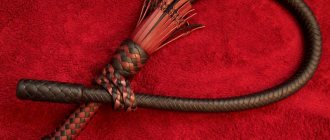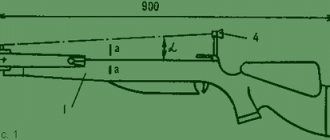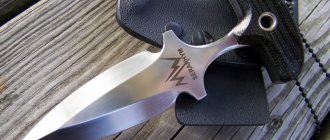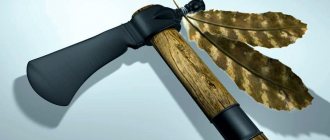Kuban Cossack whip Whips and whips have been part of the arsenal of human tribes engaged in hunting and cattle breeding since ancient times. Over time, they were transformed into special means of controlling mounts, while simultaneously maintaining the function of auxiliary combat or hunting weapons. In the Russian tradition, Cossack whips have become very famous and widespread. They not only thoroughly entered into the traditional way of life of the Russian Cossacks, their rituals and culture, but also became an integral attribute and symbol of the Cossack.
How to make your own top
If you have the skin, patience and perseverance, then you can make a top with your own hands; an example of production is shown in the video.
The basis is explained in the video, the types of weaving are named, and specific examples of leather weaving can be easily found on YouTube.
The length of the top is from 50 to 100 cm; in my opinion, it is most optimal to choose the length of an outstretched arm - such a top fits well along the belt and allows you to keep the aggressor out of close combat. The 50 cm model is convenient to wear folded in a semicircle in the inner pocket of a jacket. From a carrying point of view, this is more convenient, but it makes it impossible to quickly take it out and use it.
If desired, the ball can be strengthened by putting a piece of lead weighing 20-35 grams into the cue ball. Previously, a bullet was placed there, and the calibers of that time were no match for modern ones. But with a weighted cue ball, the ball turns into a percussion shotgun with all the ensuing consequences of the criminal code.
More about survivalist weapons:
Scourges in Antiquity
The surviving works of Greek historians bring to us interesting facts about the use of whips. In addition to using whips to punish offending slaves, the Greeks, noticing how the Scythians skillfully wielded arapniks, hired them as keepers of order. Several wild Scythians with whips quickly dispersed the crowd, which was tens of times larger than them. At the same time, the whip was a more humane weapon than the modern batons of riot police.
The battle tactics of the nomadic tribes of that era looked like this:
- At first, the opponents fired at each other with bows;
- Then the spears went into battle;
- Swords and axes were used in close combat (daggers were used as a last resort).
Since the swords of those times were short, where it was impossible to turn with a spear, whips were used. The blows of the whip affected not so much the enemy as the enemy horses. Sharp blows of the whip not only knocked out eyes, but also tore clothes and skin. It was the whips that influenced the development of full Sarmatian armor, since blows from flexible weapons were unpredictable, and it was not always possible to hide from them behind a shield. Famous warriors of that era fought off arrows and darts with arapik. If at long distances the warriors of the steppes used lassos, then at short distances they were successfully replaced by whips. With a deft blow one could snatch an ax or sword from the enemy’s hands. Some warriors became so familiar with whips that they could use them as a sling.
Description [edit | edit code ]
The whip was most often made by tightly weaving leather straps, with a bag at the end. Sometimes a weight was placed in the bag (“slap”). One of the varieties of lashes among the Kalmyks, “tashmg,” was made not by weaving narrow leather straps, but by stitching several relatively wide strips of rawhide with a thin leather cord-thread. Instead of a slap, the whip could have several tips for the same purpose: to “dissipate” the excess energy of the tip of the whip, which alone could tear the horse’s skin if hit too hard. Sometimes a lead weight or a bullet was sewn into the slap out of cheekiness (provocative behavior). In this case, the whip had to be used more carefully, because the force of influence of the weighted tip naturally increased.
There are several types of whips.
Kalmyk whip
The lashes of different tribal Kalmyk clans had design differences. Usually, all Kalmyk whips had a flexible leather part wound around the shaft from the side. Some Kalmyk whips had a smooth, almost unbending leather whip. The Kalmyk whip “malya” was closest in design to the Don whip and often differed only in the way it was attached to the shaft. The Kalmyk whip “tashmg” had a special difference: the leather whip was not woven, but was made by stitching several layers of relatively wide strips of rawhide with a thinner strap. Kalmyks skillfully used whips for horseback hunting of wolves and hare, as well as against thieves.
Kuban whip
The Kuban whip has a relatively short handle braided with leather, which smoothly turns into the weave of the whip itself.
Statutory whip
The Russian Imperial Army used whips made in accordance with special requirements approved by orders.
The volchatka is a shortened version of the whip, but it does not have a pronounced handle. In terms of weaving, it is denser than a whip; in modern production, a metal cable is woven into the whip in the center, which gives it elasticity and strength.
The wolf cub is also known as the wolf-cat, but now this name is rarely used. Initially, wolves were intended specifically for beating a wolf from a horse’s saddle.
In the current edition of the Criminal Code, the volchatka is not a bladed weapon (it does not have a percussion-shot effect) and does not belong to special equipment. So you can carry it with you absolutely legally.
Despite the lack of a crushing effect, a blow with a wolf is very painful. Applying a light slap from a half-swing, without investing strength and body weight, is so painful that it paralyzes the muscles. A blow with full force can cause a painful shock. You probably read it in history books - screw it to death? So, a dozen blows from the lupus at full force can easily send you to the next world, with no fractures.
A blow from a baton is similar to a blow from a rubber baton, only more painful. A stray garage dog the size of a Rottweiler, having received a mid-range blow to the body, forgot its aggressive intentions and walked away with a squeal and on half-bent legs.
The small size of the wool allows you to carry it in a large side pocket of a jacket, you can pass it through belt loops along the belt or tuck it into the belt inside your pants. The most convenient way is to encircle the top along the belt. Belt loops hold the top and, at the same time, do not interfere with its removal. Pulling out the top completely replaces the swing and you can hit right from the waist.
Those who like to look for a cigarette in the evening and at night, having grabbed the thighs with a half-swing, lost their balance and did not really try to find it. So, as a self-defense item, the wolf cub is convenient because it does not require special skills to use; even with a stick, it is more difficult to work with.
Options and principles for using a whip
| Scope of application | Purpose and features of the whip |
| Agriculture | Forcing animals in agriculture and cattle breeding. Cattle are frightened by the click that the whip makes or react to the blows. |
| Punishment system | A tool for carrying out the most severe and cruel types of punishment for people. A well-placed blow of the whip cut the skin and nearby tissues to the bone. After 10-15 such blows, the whip became damp with blood, so it had to be changed. |
| Cavalry equipment | Element of horse control, as well as an effective auxiliary weapon. |
| Hunting | The rider's main tool for many methods of horse hunting for various game, from hares to wolves. |
| Animal training | Currently used by circus trainers for various animals, as well as by dog handlers. |
When striking, the tail of the whip, thinned towards the tip, is capable of developing supersonic speed. The blow of a fairly flexible whip produces a characteristic sound, similar to a click. The damaging property of the whip could be enhanced by special weights on its tip. A similar design was sometimes called a “Roman scourge” (in Rus' it was more often called a “flail”) and was in service both in the ancient Russian squads and in the Mongol horde.
Warlash
The damaging property of the whip could also be purposefully weakened, so as not to injure the horse’s skin with an excessively strong blow when riding. For these purposes, the whip was equipped with a relatively wide leather plaque (“slap”) at the tip, or, as an option, the tip was made from several tails.
In Domostroi, the whip was indicated as an instrument of domestic punishment. Among the most important ritual rites, the following can be noted: on the wedding day, the groom had to put a whip in his boot as a sign that marital power in the house belonged to him. This ritual is still reflected in the traditions of the Cossacks, distinguishing a married Cossack in combat.
The whip served as an instrument of punishment (including judicial) within the established class system. The grounds for imposing such punishment were quite serious crimes, including murder and participation in a riot. Whips eventually became a lighter version of the whip and were also used for less severe public punishments.
Don Cossack whip
Use of the whip among nomadic peoples
In the legends and tales of nomadic peoples, whips are constantly mentioned. Arapniks and whips were used by hunters and shepherds. The warriors used the whip. The “naked fight” was very popular among the Kyrgyz, when naked riders with whips tried to knock each other out of the saddle. Everyone is divided into teams and, as in a real battle, they help each other. The use of the whip taught Kyrgyz warriors the ability to fight with any available object. The Chinese in the second century BC experienced the lashes of the Kirghiz.
The steppe warriors developed a system of whip fighting, in which the emphasis was placed on striking pressure points. Moreover, the blows were applied not only with the whip itself, but also with the handle. In folklore, there is often a special blow to the head, from which “the head flew off the shoulders.” It’s difficult to say now whether this is true or not, but an experienced shepherd even today can break a wolf’s back with one blow of his whip.
Differences in the use of the whip
The areas of application of the whip varied significantly depending on the types of social order. If for the most ancient slaveholding states the whip served primarily as an instrument of coercion against the dependent majority of the population, then among nomadic tribal formations whips and whips came into much wider use, covering the bulk of society.
Among nomadic peoples
Tribes and peoples whose traditional economic structure was nomadic cattle breeding built their society more monolithically. Its basis was the almost obligatory combination for each of its full members of the functions and skills of a warrior, hunter and shepherd-cattle breeder. In each of these types of activities there was a natural use of the whip, which led to the inclusion of this tool in everyday use, and its individual elements began to be given special distinctive signs of belonging to the genus, as well as a place in its hierarchy.
Accordingly, special rituals appeared related to the granting of the right to own and wear whips. It was precisely for nomadic peoples that the use of whips was characteristic of the obligatory rites of initiation of the younger generation, in ritual fights of a competitive nature. These traditions have been preserved to this day by many peoples, including Kazakhs, Kalmyks, Kyrgyz, Tuvans and others.
In the era of antiquity
Since the basis of the economy of antiquity was agriculture, and the strengthening of statehood was associated with large-scale construction work, the most common purpose of whips and whips was their use as a tool for coercing slaves. Accordingly, the right to own such an instrument was not widespread, but, on the contrary, was considered an attribute of certain powers of power.
This phenomenon was reflected in rituals. Thus, whips were an attribute in the depiction of many gods in Ancient Rome (Apollo, Dionysus, Bellona and others). There was a practice of whipping women to “increase fertility.” In general, lashing in antiquity served as a common form of punishment for both slaves and other categories of the dependent population.
In the military sphere of antiquity, whips found relatively limited use: usually as a specialized tool for controlling horses in equestrian units. A heavy single-tailed whip with a metal weight at the tip was used as an auxiliary weapon for ancient Roman legionnaires.
Whip and its varieties
Subsequently, the combat whip evolved into the whip and arapnik. The most popular variety of arapnik in our time is the whip. The appearance of this name is associated with the word “naga”, which means snake. There were many types of whips, each master added some of his own features. These whips are called differently, depending on the place of manufacture.
- Don whip;
- Kuban whip;
- Ural whip;
- Arapnik;
- Volchatka;
- Tatar whip;
- Belt whip.
The Cossacks, whose martial art is the heritage of the steppe warriors, often used the whip in battle. Just don’t rely on the words of some modern “masters” of Cossack combat, who claim that the whip was a super weapon, and a Cossack with it could easily kill five people. In battle, the whip was used as a last resort, when all the weapons were broken or lost. Basically, shocking blows to the face were applied with a whip in order to break through and gallop away. There were virtuosos who could pull an opponent off a horse with a whip or inflict mortal wounds, but these are isolated cases. And why study whip fighting when the Cossack had a rifle, a saber, a pike and, in extreme cases, a dagger? The whip was used for corporal punishment, and it was a symbol of the power of a married Cossack.
How to work with a top
In terms of style of work, the wolf is closer to the checker and flanking.
Here is an example of such work with a top.
Very often, when learning to work with a checker, the student is first given a top and with it he practices flanking techniques. This is due to the fact that if the exercise is performed incorrectly, if the student hits himself, he will only receive painful sensations and this will force him to act carefully; when working even with a training saber, such a blow leaves abrasions and can cut the skin.
Having mastered flanking with a top, you can easily repeat the same exercises with a checker. But you will have to learn how to work with a whip, because the whip is softer and more flexible.
However, for simple self-defense there is no need to memorize complex techniques or develop flanking techniques for years
Here are simple techniques for using the wolf claw against attackers, please note that even neat demonstrative spankings with the wolf claw are very painful
Cultural significance
In late Cossack society, the whip was a sign of the status of a full-fledged adult combat Cossack. In some villages, by the way, it was exclusively married (given by the father-in-law to the son-in-law at the wedding), but not in all.
The whip was usually hung in the house on the door frame, on the left. She was considered something of a mascot for the house. For example, during a quarrel, the owner could throw his whip at the feet of the offending guest. If he picked up the whip and handed it back to the owner, it meant that he wanted to reconcile and not make a fuss.
But if the guest simply left, and worst of all, stepped over the whip, such a vendetta could begin that where were the wimpy Italians Montagues and Capulets.
Weapons from improvised means
— How to arm yourself with what you have at hand.
I had heard about wolf cub before, but this was my first time seeing what it was like. Convenient and effective means of self-defense. The new is the well-forgotten old.
Good day! Please tell me, are your products equipped with any permitting documentation, such as a certificate of conformity (about what is not a chemical substance)?
When buying a vacuum cleaner, do you also require such a certificate? What about a hammer?
In fact, lupus does not have signs of a chemical weapon and is not a chemical weapon for its intended purpose. So she needs a certificate just like a hammer.
The whip can be carried completely unnoticed by placing the handle in the inner pocket of the jacket and passing the rest into the sleeve. And so - thanks for the video - everything is explained clearly
Weaving arapnik
Weaving a whip can occur in various ways, but they can all be divided into two large groups:
- Weaving with vitny (core);
- Regular weaving without a core.
The oldest weaving technique is snake weaving. The pattern of the lash woven using this method resembles the scales of a snake. The handles for the whips are carved from fruit trees and have a ball at the end that serves as a grip. The handle is braided with leather straps. The more straps, the better the whip, but it will be more difficult to weave.
To weave arapnik with vitny, you will first need to make this core. In modern conditions, it is best to use a nylon sling for these purposes. Such a core will be much stronger and more elastic than a traditional leather one. Using electrical tape, the sling is attached to the handle, after which it is braided with leather.
Arapnik and other whips can be used for self-defense on the street; they do not fall under the category of bladed weapons and can be freely carried with you. The main thing to remember is that only training will help you effectively use the whip in battle.
How to make your own arapnik
Making a whip with your own hands, including in the form of a traditional Cossack whip, is not something difficult. This ancient military weapon can be made using fairly modern materials, based on diagrams and practical recommendations.
Making your own arapnik begins with making a handle. For this, hard types of wood are traditionally used - beech, oak, ash, acacia. In general, the material of the handle should be strong, but light, so it is also permissible to use textolite or ebonite, but light metal alloys, on the contrary, are not recommended. To prevent the handle from becoming too thick, before braiding it is necessary to reduce its diameter by an amount that is equal to the thickness of the strips of leather used for braiding.
The classic requirement when making whips is to use natural rawhide, preferably cowhide, as raw material. Belts prepared for weaving must first be soaked in ordinary water: the weaving process will become much easier as a result, and after the leather has dried, the weave will become stronger.
Those who want to correctly determine the size of the whip according to the standards of the Kuban-type whip can do it this way: extend your hand in front of you and rotate the whip in a vertical position. The whip should not reach the face of the driver.
The weaving of the whip-arapnik is made in two main types: regular or with a laid core (vitem). The presence of a core makes the whip less flexible, but enhances the blow, which is why such whips were most often used for hunting or fighting.
Weaving with vitna
In patterns of this type of weaving (for any classic type of arapnik, including a whip), horsehair is traditionally used as the core. In modern conditions, it is not easy for many to obtain it, so a nylon cord attached to the future handle is quite suitable for the base. The strips are screwed to the base so that those that go from left to right are wound first, and then the opposite ones. The end is secured with threads.
Approximate weaving pattern for making a whip
Regular weaving
Braiding without the use of a core is, in fact, reminiscent of weaving a regular braid. Leather strips for weaving are cut using a regular stationery knife, forming a narrowing towards the tip, and processed with an edge cutter. There may be 4-6 stripes, but for a “classic” whip, 8 are recommended, and for a “reinforced” whip – 10, 12 and even 14.
The shape of the slap (a leather bag at the end of the striking part of the whip, into which a weight is placed to enhance the blow) is recommended to be trapezoidal, which is considered the most convenient shape. It is better to make a slap for a whip not in one piece, but with lace. If necessary, a weight can be placed in the resulting pocket, which can be a piece of lead or a bullet approximately corresponding to a 5.45 mm caliber.
The history of the appearance of whips
It is difficult to say when the first lashes appeared. It is known for certain that the history of nomadic peoples engaged in cattle breeding is closely connected with the appearance of whips. Each steppe warrior had his own arapnik whip. In Europe, every horseman had a whip; the shepherd also could not imagine his work without a long whip.
The whip was distributed throughout the world; ancient frescoes in Egypt depict people with whips in their hands. After the discovery of America, the shepherd's whip migrated to places where it continues to be used for its intended purpose. Most likely, even in Okinawa they used some kind of whip, although historical documents do not say about this. But in China, many used their long braids as a whip, weaving iron balls into them.
Other meanings of this word:
- “... does not torment, but teaches goodness”
- “... does not torment, but teaches good” (last)
- "Accelerator" for a horse
- "Accelerator" of the coachman
- “First for the informer...”
- “Not a pointer for you... and a whip”
- "Gas pedal" in the hands of the coachman
- Cab driver's "gas pedal"
- "Gas pedal" of the coachman
- Driven by the coachman
- "Pusher" of horses
- "Pusher" of the shepherd
- "Encourager"
- "Stimulus" for the horse
- Shepherd's "Nutcracker"
- "Tongue" of the coachman
- "Language" of the shepherd
- (figurative meaning) government system of oppression, violence (rhetorical)
- Gingerbread alternative
- An Englishman in such a situation will most likely remember a stick and a carrot, and we will remember... and a gingerbread
- Antipode of gingerbread
- antonym of gingerbread from a famous saying
- arapnik
- attribute for carrying out trade execution
- Attribute for trade execution
- Coachman attribute
- Sadist attribute
- Beach
- Scourge to gingerbread
- Shepherd's Scourge
- a scourge, but not a homeless person
- Scourge, whip
- big whip
- Educational antipode of gingerbread
- Educates with gingerbread
- flexible shepherd argument
- Flexible shepherd's assistant
- Long rawhide belt with handle, used for corporal punishment
- long rawhide belt with a handle, used for corporal punishment
- Dovid (present David Fixman) (1900–55) Russian poet
- informer first...
- addition to gingerbread
- whistles over the piebald couple
- the famous polar bear that lived in the Berlin Zoo
- driver's tool
- tool to increase horse speed
- horse whip
- Horse whip.
- musician from Topelius's tale
- Gingerbread's partner
- Gingerbread's partner in education
- Gingerbread's partner in education.
- Gingerbread's parenting partner
- gingerbread's indispensable "friend"
- Gingerbread's inedible cousin
- Needed by a coachman and a sadist
- Opponent of the carrot in education
- carrot opponent in politics
- Shepherd's tool
- instrument of prodding
- The conductor has the baton, and the shepherd has it?
- The conductor has the baton, and the shepherd has the baton
- Gingerbread's parenting partner
- shepherd's helper
- Shepherd's helper.
- shepherd's biting henchman
- A shepherd's biting assistant.
- Pedagogical application to gingerbread
- Shepherd's Whip
- Shepherd's Whip
- The coachman was urged on.
- Driven the coachman
- fastening belt
- political opponent of carrot
- Political opponent of the carrot (book)
- political counterbalance to the carrot
- animal motivator
- shepherd's affiliation
- Shepherd's accessory, long belt with handle
- Gingerbread Counterweight
- shepherd's working tool
- Russian poetess, daughter of composer A. Scriabin
- Sarah (Ariadna Skryabina) (1904-44) Russian poetess, daughter of composer A. N. Scriabin, participant of the Resistance Movement in France, died in battle with the Nazis in Toulouse
- Cattle Driver
- controls: ... and carrot
- Means of education
- The driver has the gas pedal, but what about the coachman?
- The driver has the gas pedal, but what about the coachman?
- Horse speed booster
- The shepherd's biting argument
- biting scourge
- biting shepherd's assistant
- whip, big whip, whip, scourge










